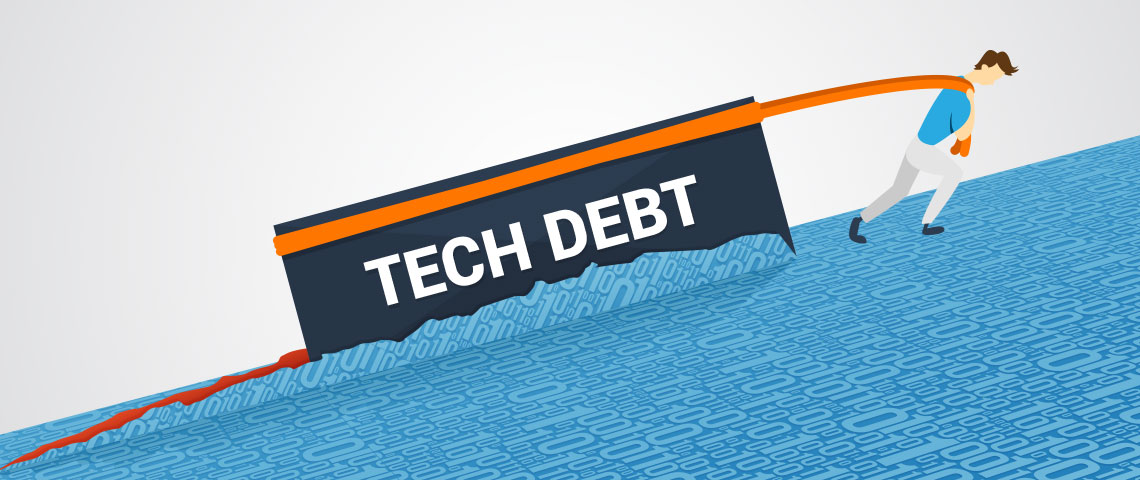Strategies for Managing Technical Debt in Software Projects
Introduction
Technical debt is an unavoidable reality in software development. Whether it results from rushed coding, outdated architecture, or short-term workarounds, technical debt can slow down development, increase maintenance costs, and reduce software quality over time.
If not managed properly, technical debt can spiral out of control, leading to performance issues, security vulnerabilities, and high refactoring costs. However, when strategically addressed, businesses can balance speed with maintainability, ensuring long-term software stability.
This article explores what technical debt is, its causes, risks, and proven strategies to manage and reduce it effectively in software projects.

What is Technical Debt?
Technical debt refers to the cost of shortcuts in software development that may speed up initial delivery but require additional work in the future. These shortcuts often result in poor code quality, scalability issues, and inefficient architectures.
🔹 Example: A team hardcodes database queries instead of using an ORM framework to meet a deadline. This shortcut saves time in the short term but creates scalability and maintainability issues later, requiring expensive refactoring.
Types of Technical Debt
Technical debt comes in various forms, each affecting software projects differently:
1. Code Debt
Poorly structured code, lack of modularization, or excessive dependencies make applications difficult to maintain.
2. Design Debt
Flawed software architecture or inconsistent design patterns make it hard to extend features.
3. Documentation Debt
Missing or outdated documentation makes it harder for new developers to understand the codebase.
4. Testing Debt
Skipping automated testing or relying solely on manual tests increases the risk of bugs and system failures.
5. Infrastructure Debt
Using outdated or inefficient hosting environments can reduce performance, security, and scalability.
Each of these debts compounds over time, making software projects harder to manage.
What Causes Technical Debt?
Several factors contribute to technical debt in software projects:
1. Rushed Development & Deadlines
Pressed for time, developers sometimes resort to quick fixes that leave the codebase less than optimal. When you need to launch an MVP rapidly, consider building it on a no‑code platform first and migrating to a full code‑based solution once the concept is validated.
2. Lack of Proper Documentation
Skipping documentation leads to long-term confusion and inefficiencies for future development teams.
3. Poor Code Reviews & Quality Standards
Without proper code reviews and best practices, poorly written code accumulates.
4. Rapidly Changing Business Requirements
Frequent changes in project requirements may force quick fixes rather than well-planned solutions.
5. Ignoring Refactoring
Delaying necessary code improvements and updates leads to increasing complexity and maintenance costs.
Managing these root causes is crucial for controlling technical debt early.
The Risks of Ignoring Technical Debt
If left unchecked, technical debt can severely impact software projects:
❌ Slower Development – Complex, messy code makes adding new features difficult.
❌ Increased Costs – Fixing accumulated issues requires more resources and development time.
❌ Security Vulnerabilities – Unpatched legacy code is a major cybersecurity risk.
❌ Poor Performance – Inefficient code affects application speed and stability.
❌ Low Developer Productivity – Developers spend more time debugging than innovating.
Addressing technical debt early and systematically prevents these risks from escalating.

Best Strategies for Managing and Reducing Technical Debt
Effectively managing technical debt requires a proactive approach. Here are proven strategies:
1. Adopt a “Tech Debt Acknowledgment” Mindset
Technical debt is inevitable, but acknowledging it and managing it proactively makes a difference.
✅ Strategy: Keep a technical debt log documenting shortcuts and potential risks.
2. Set Code Quality Standards & Best Practices
Maintaining high coding standards prevents avoidable debt accumulation.
✅ Strategy: Establish coding guidelines, enforce code reviews, and follow best practices like SOLID principles and DRY (Don't Repeat Yourself).
3. Refactor Code Regularly
Scheduled refactoring helps reduce complexity and inefficiencies before they escalate.
✅ Strategy: Implement incremental refactoring, breaking large improvements into smaller, manageable updates.
4. Prioritize Automated Testing
Skipping tests increases risk and makes future updates costly.
✅ Strategy: Adopt Test-Driven Development (TDD) and maintain robust unit, integration, and regression tests.
5. Maintain Up-to-Date Documentation
Poor documentation makes onboarding new developers difficult and increases long-term confusion.
✅ Strategy: Use automated documentation tools like Doxygen or JSDoc to generate API and code documentation.
6. Balance Speed & Code Quality in Agile Development
Teams often rush features, accumulating technical debt. Agile methodologies can balance both.
✅ Strategy: Allocate time for technical debt reduction in Agile sprints (e.g., every 4th sprint focuses on tech debt fixes).
7. Implement CI/CD Pipelines
Continuous Integration & Continuous Deployment (CI/CD) reduces deployment risks and improves maintainability.
✅ Strategy: Use Jenkins, GitHub Actions, or GitLab CI/CD for automated testing and deployment.
8. Use Static Code Analysis & Code Review Tools
Automated tools help identify complex, inefficient, or risky code early.
✅ Strategy: Implement SonarQube, ESLint, or CodeClimate for continuous code quality monitoring.
9. Regularly Review & Refactor Legacy Code
Older codebases often contain hidden technical debt that accumulates over time.
✅ Strategy: Conduct monthly code audits to identify refactoring opportunities.
10. Encourage Cross-Team Collaboration
Poor communication between developers, testers, and product managers leads to overlooked debt.
✅ Strategy: Foster collaboration through regular dev meetings, retrospectives, and knowledge-sharing sessions.

Real-World Examples of Managing Technical Debt
1. Facebook’s Approach to Technical Debt
Facebook actively addresses technical debt through continuous refactoring and automated testing. They allocate dedicated engineering teams to reduce legacy code issues.
2. Google’s Code Review Culture
Google enforces strict peer code reviews to maintain code quality, preventing unnecessary technical debt.
3. Netflix’s Scalable Architecture
Netflix embraces microservices architecture, reducing monolithic dependencies and making tech debt management easier.
These companies prove that managing technical debt effectively is essential for long-term scalability and performance.
The Future of Technical Debt Management
🔹 AI-Powered Code Optimization – AI-driven tools will automatically suggest code refactoring for better efficiency.
🔹 Automated Debt Tracking – Platforms will provide real-time monitoring of tech debt accumulation.
🔹 AI-Enhanced Code Reviews – Machine learning algorithms will detect inefficient patterns and recommend fixes.
As software development evolves, technical debt management will become smarter and more automated.
Final Thoughts
Technical debt is unavoidable but manageable. Companies that actively track, refactor, and automate best practices can prevent debt from crippling their projects.
By integrating code quality standards, CI/CD, automated testing, and Agile strategies, development teams can maintain scalability, security, and long-term software stability.
Managing technical debt effectively reduces long-term costs, enhances code maintainability, and improves overall software performance.
Looking to scale more efficiently? Connect with iDelsoft.com! We specialize in developing software and AI products, while helping startups and U.S. businesses hire top remote technical talent—at 70% less than the cost of a full-time U.S. hire. Schedule a call to learn more!





